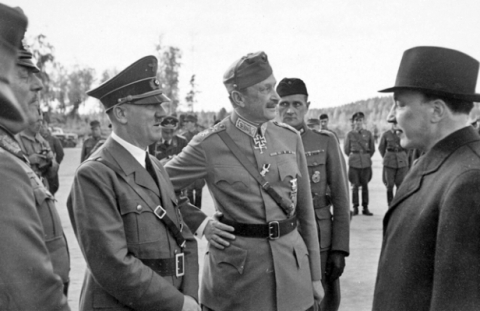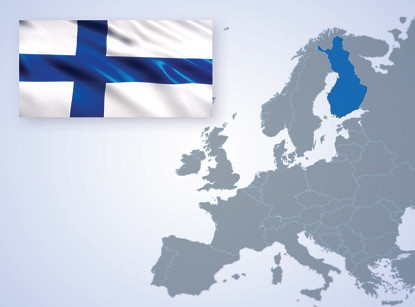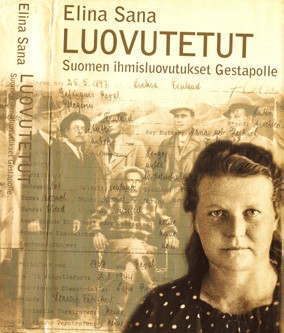Did the Holocaust Pass Over Finland?
 An interesting event in Finnish-German relations was the unexpected visit of Hitler to Finland, when Commander- in-Chief Mannerheim celebrated his 75th birthday on June 4, 1942. (Credit: Wikipedia)
An interesting event in Finnish-German relations was the unexpected visit of Hitler to Finland, when Commander- in-Chief Mannerheim celebrated his 75th birthday on June 4, 1942. (Credit: Wikipedia)
FINLAND AND THE JEWS DURING THE SECOND WORLD WAR
Over 80 years has passed since the outbreak of WW2 and there are still many things we do not know. We have learned about ghettos, concentration camps, partisans, and lately more about the collaboration of the local population. We know less about what happened in the Nordic countries: Denmark and Norway that were occupied by the Germans, Sweden that was neutral and Finland who fought together with Nazi-Germany. I have researched the Holocaust period in Finland, especially the fate of Jewish prisoners of war. I will give some background information on this North European state, considering steps leading up to the Second World War in Finland and then, in short, tell the story of Finland and the Holocaust.
PART 1
Finland borders Sweden in the west and Russia in the east. During its unique history, it has belonged to both. After declaring independence in late 1917, a civil war broke out between the Whites (nationalists) and the Reds. The Reds, supported by the Soviet Union, wanted to turn all of Finland socialist and at the outset conquered southernmost Finland. Former officers of the Army of the Russian Czar (foremost among them General Gustaf Mannerheim, appointed commander in chief) and German trained soldiers (Jäger), fought for the Whites. When Germany sent forces to assist, the Whites were victorious.
The Parliament initially sent an invitation to the German prince of Hessen to become the King of Finland. As Germany lost in WW1, nothing came out of the plan: Finland became a democratic republic and a player in the fight for spheres of interest of the Major Powers.
In between the world wars there was cultural, police, military, and commercial cooperation with Germany and close cultural and commercial ties with especially Sweden and the other Nordic countries.
In the thirties several delegations went to Germany: Finnish policemen as guests of their German colleagues and senior army personnel for training. The Finnish State Police (Secret Police) was fighting communists and its senior personnel established ties with Germany. Right-wing groups, such as the extreme nationalist Academic Karelia Society (AKL), and the Patriotic People's Movement (IKL), were a minority, but loud and active, especially in the 1930's. It is interesting to note, that many academicians belonged to these groups. As an example, the Rector of Helsinki University during the continuation war, Professor Rolf Nevanlinna (former Neovius), was a right-wing activist, active in recruiting volunteers to the Waffen SS. Russophobia was central in their ideology but there was antisemitism as well.
In 1938 the Soviets demanded to build Soviet naval bases on Finnish territory to protect Leningrad from German expansionism. Finland, suspicious of Russian intentions, took an uncompromising position and disagreed in the name of neutrality.
On November 30, 1939, the Soviets attacked without a formal declaration of war and expected to win within two weeks. The Finns feared what their fate might become: Soviet occupation. They expected Sweden to come to their assistance, arms were delivered but only volunteers joined in. Britain also refused to come to Finland's help. The Finns had poor ammunition and a small army but gave a brave fight under tough circumstances: fighting in cold winter conditions without allies, against a far superior enemy for 105 days and prevailed. Finland had to cede some territories but remained independent. The Winter War was the first of three wars the Finns fought during WW2.
When Finland tried to enter into a defense alliance with Sweden, Moscow sent a warning to the Finnish government. Unable to get or buy arms, Finnish leaders, secretly turned to Germany, negotiations were held in Germany and on Finnish soil. In August 1940, Commander-in-Chief Mannerheim met a representative of Generalfeldmarschall Hermann Göring, who proposed an exchange: permission to transport German troops to Northern Norway through Finnish territory and a German agreement to sell arms and food to Finland. In September 1940, German troops landed onshore in Vaasa, and German soldiers were seen in Lapland for the first time. This has been regarded as one of the important links in the events that led Finland to war in 1941. The German negotiators refused to document any of the agreements.
In the forthcoming months meetings were of a more practical kind, while Generals E. Heinrichs, Finland´s Chief of the General Staff and P. Talvela, Mannerheim's special envoy to Germany, met with Chief of Staff of the Wehrmacht, Franz Halder and others from the Nazi military and political leadership.
Finland did not join in immediately, when operation Barbarossa was initiated by Germany on June 22, 1941, the Finns waited for the Soviet Union to fire first. As Germany also attacked through Finland it did not take long. On June 25, the Soviets bombarded southern Finland and Finland joined the war as a de-facto ally of Nazi Germany. The Finns later labelled the war the Continuation War to stress that it was only a continuation to Soviet aggression from the Winter War. The official historic narrative in Finland until recently was that Finland was drawn into fighting with Nazi-Germany.
The fact is that not only Russophobia, now anti-Bolshevism, was shared by the allies. The Finns, both from the Right as well as many from the Left, had a vision of a Greater Finland and a will to retake Karelia. In the Order of the Day on July 14, 1941, Commander-in-Chief Mannerheim declared, in a similar manner as he had done in 1918. that "…I will not set my sword to the scabbard before Finland and East Karelia will be free."
Hitler was interested that the Finns would attack Leningrad from the north. The Finnish army proceeded in Eastern Karelia and in late 1941, it was in Finnish hands. Mannerheim decided not to attack Leningrad and Finland entered a stage of trench warfare until 1944.
An interesting event in Finnish-German relations was the unexpected visit of Hitler to Finland, when Commander in Chief Mannerheim celebrated his 75th birthday on June 4, 1942. Hitler, who seldom left Germany, came to congratulate him in person. Mannerheim was nominated Marshal of Finland on his birthday.
The Finnish leadership, under the influence of the Marshal, understood in the spring of 1943, that Germany was about to lose the war: the Wehrmacht was retreating on many fronts. Their attack on the Soviet Union from Lapland was not going well and when the Soviets attacked on the Karelian Isthmus in 1944, Finland looked for a way out of the war: an armistice with the Soviet Union was signed in September 1944. The Finns agreed to fight the Germans and drive them out of Finland. The third war erupted, the so-called Lapland War. The Germans were ousted from Lapland, where they had had, at the peak, 200,000 soldiers. The Germans burned down everything they could on their retreat.
PART 2
The fate of Jews in Finland during the Holocaust period can be dividedinto three categories: Jews who were Finnish citizens, Jewish refugees in Finland during the wars and Soviet Jewish POWs caught by the Finnish Army.
Jewish citizens
Jews came to Finland, mainly as soldiers in the Czar's army, around the middle of the 19th century. They were granted citizenship only in 1918, after Finland gained independence. It took many years until all Jews received citizenship.
They made efforts to integrate, without totally giving up their Jewish identity. Many Jews changed their surnames, Waprinsky became Wardi, Salutskij: Sella, Seela and Seera etc. getting rid of their Russian-sounding surnames while adapting Hebrew-sounding shorter names.
The Jewish school (9 classes) in Helsinki recently marked 100 years of existence. Zionist activity and cultural life were lively in the Jewish communities especially in the 20's and 30's. The Jewish community never had more than 2,000 members. Jews were mobilized to the Finnish army together with other Finns: 352 Jewish soldiers and some 40 women in various military tasks served during the wars of 1939-1944, 23 soldiers fell during all wars - a significant sacrifice for such a small community. Equal service in the defense of Finland was also a way to integrate.
The sudden reality in 1941, facing a war on the side of Nazi- Germany, understandably caused widespread concern - German soldiers were seen on the streets.
In the Continuation War Finnish army units fought side-by-side with the Wehrmacht. The Jews who spoke Yiddish and German were often drafted as interpreters and that brought them in direct contact with German soldiers and officers. A Finnish Jewish soldier, Sholka Smolar, even established a field Synagogue on the front, where Jewish soldiers met on Shabbatot and Jewish festivals. This reality was among the reasons that local Jews felt they could trust the Finnish democracy to care for them. Salomon Klass, a revisionist Zionist, returned from four years in Palestine to take part in the defense of Finland. By the time of the Continuation War, he was a lieutenant and was, quite exceptionally, commanded to head a Finnish battalion in fierce battles in Karelia. He got praise from the German officers and a German colonel came to thank him. Klass pointed out that the colonel could address him in German as it resembled his mother tongue Yiddish. The surprised German colonel said he had nothing personal against Jews, leaving the tent while rising his arm in a Heil Hitler salute. Klass refused to accept the Iron Cross he was awarded as did three other honored soldiers.
The Finnish front was important for the Nazi-Germany and the ties with Finland were strengthened, but "2,300 Finnish Jews" were included in the plans for the implementation of the Final Solution at Wannsee in January 1942: Himmler arrived in Helsinki at the end of July 1942 and there is proof that he then intended to "solve the Jewish problem" in Finland. The Finnish Prime Minister Rangell later recalled that he had said to Himmler, that the Jews in Finland are decent families and individuals, their boys serve, as other Finns, in the Army, and the Jews are as respected as other citizens. "We have no Jewish problem." Thus, in Finland, not a single Jewish citizen fell in Nazi hands during the Holocaust.
Jewish refugees
After Hitler rose to power in Germany, hundreds of letters were received by the Jewish community from Polish and Austrian Jews looking for a safe haven. Finland was traditionally a homogenous society, where Jews and gypsies were small minorities. The Jewish community had in most cases no capacity to assist their Central European brethren.
The first refugees arrived in the mid 30's. Most came in order to continue overseas through the open port of Liinahamari in the very north of Finland. This harbor was one of the few ways to get overseas to the United States and South America in the late 1930's. In 1941 this way was closed.
In the autumn of 1938, a ship with some 50-60 Jewish refugees with German passports arrived in Helsinki harbor. The same ship had previously brought refugees that were permitted to stay, but now they were denied entrance to Finland. Of some 350+ Jewish refugees that were registered by the Interior Ministry, only some 150-200 remained in Finland during the war. The Jewish community, with assistance from the Joint and HICEM and some Finns, financially supported the refugees, though it proved difficult.
The refugees were not treated the same way as Finnish Jews. When the Continuation War broke out, the Finnish Interior Ministry decided to move the refugees to the countryside. In the early spring of 1942 male refugees were sent to work in the north, in extremely difficult circumstances, close to German troops. When they were later moved again, a certain respected member of the Jewish community, Abraham Stiller, received a postcard from one of the refugees, stating that some of the refugees were taken to the State Police headquarters in Helsinki and hinting that they were in danger. Stiller succeeded in alerting politicians, but not to prevent the handing over of eight refugees to the Gestapo. Seven of them were annihilated in Auschwitz and only one survived and established a new family in Israel. Most of the remaining refugees were moved to Sweden in 1944.
Soviet Jewish prisoners of war
Some 65,000 Red Army soldiers were taken as POWs by the Finnish army during the Continuation war. Among these some 500 were Jewish. They faced a difficult time in POW camps and in POW units.
The Finnish Military HQ ordered to separate the POWs according to their "nationality." Altogether 89 nationalities can be found on lists from POW camps. Among them the large majority were Russians, Ukrainians, Finnish related peoples, and dozens of other nationalities. The Jews were initially included among the Russians but were later counted apart. While deciding to which camps to send a POW, special attention was to be given…"to officers in the Red Army, Commissars, political POWs, and suspected Jews." Thus many "suspected Jews" found themselves in the two specific camps: for officers and political prisoners.
The granddaughter of POW Lazar Poljakov, now in the USA, was shocked to hear, that her grandfather "had been suspected being a political agitator", handed over and then killed by the Gestapo and its Finnish collaborators in Northern Finland. Among some 525 POWs altogether (close to 70 Jews) transferred to the Gestapo, most were never heard of again. In Soviet archives they are considered MIAs (missing in action).
Until lately it was claimed that there was no presence of Gestapo in Finland and thus the Jews and Jewish refugees were not handed over. The eight refugees were handed over to Gestapo in Estonia on the initiative of the Finnish State Police. The truth is slightly different.
In 2008, Dr of Philosophy Oula Silvennoinen found proof for the existence of an Einsatzkommando Finnland, a unit of the Gestapo in Lapland, operative at least during 1940 till 1942. Officials from the Finnish State Police co-operated with and within the Einsatzkommando der Sicherheitspolizei und des SD beim AOK Norwegen.
The interrogation of suspected POWs was conducted by personnel from the Finnish Army headquarters. The Nazi leaders of Einsatzkommando Finnland were awarded military orders by the President of Finland.
The treatment of POWs in the dozens of camps and hundreds of POW units and work sites was in most cases brutal during 1941-42, with the situation improving in 1943. Altogether, at least 1,000 POWs were shot to death and some 20,000 others died from malnutrition and disease. Some dozens of Finns in the Einsatzkommando, and guards and administrative personnel of some POW camps, many former members of IKL, committed war crimes.
Those who survived tell difficult stories. "To be a POW is worse than death". "You become a nobody, a number", or "…there was cannibalism in the camps in Karelia." A volunteer in Finland during the war, the Swiss Dr. Piderman, was granted permission to visit some POW camps in 1942, together with the International Red Cross. He took pictures of POWs suffering from malnutrition. He tried, unsuccessfully, to engage the IRC and others to relieve the conditions in the camps.
In 2003, the journalist and human rights activist Elina Sana published an important book, The Extradited (Luovutetut) on the treatment of the refugees, Finnish communists, and Soviet POWs - unfortunately published only in Finnish. In the wake of the debate surrounding the book, Efraim Zuroff, of the Simon Wiesenthal Center, called for research into the handing over of Jewish POWs to Nazi-Germany. A commission of historians was appointed by the Government of Finland and given the task to investigate the matter. It published books based on research and gathered information in a database of some 18,000 POWs who died in captivity in Finland, available online.
The documents and data on POWs, who were extradited to the Einsatzkommando Finnland and murdered, however, have not been published.
Finland and the Finns did indeed come out wounded after the wars, there was trauma and a silence in talking about the difficult aspects of that time. Silences of History is the subtitle of another book in English on aspects of Finland's Holocaust.
Finland stands as a model for the behavior towards its Jewish citizens, has asked for forgiveness for extraditing the eight Jewish refugees (there were in fact a few more), but in 2021 it is time for the Jewish POWs who were handed over to the Gestapo in Finland to be remembered. For the sake of the relatives and for truthful memory of the darkest side of Finland's alliance with the Third Reich. As a democratic state in the European Union, time has come for Finland to give free access to archives and publish all relevant documents.
Acknowledgements and further information
https://en.wikipedia.org/wiki/Continuation_War









Comments 3
Very interesting article, giving insight to previously unknown and scarcely documented history, at least to the public. Further research by Serah Beizer (Schubak) and willingness of Finnish authorities to open their archives may shed further light.
In my opinion, the article is very interesting. The author has investigated the fate of Jew POWs very thoroughly. Let's hope that Finnish state will become more open in bringing to light different aspects of this problem.
Thank you Serah Beizer for publishing such comprehensive article about Finland prewar and WW2 period. It is time indeed for Finland to fully open it's files for the families to learn fate of their loved ones and finally have closer, even 85 later.
Jana Sokol, granddaughter of POW WW2